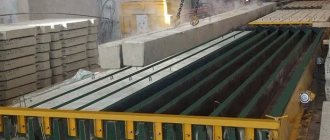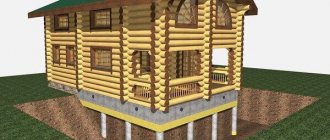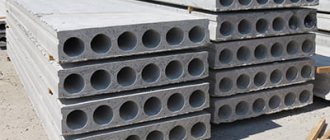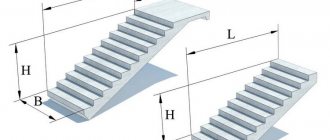The BZSK plant offers to buy reinforced concrete piles, manufactured in accordance with GOST, for use in the construction of driven pile fields. It is recommended to take a structural element such as a driven pile only of standard sizes established by standards, since the behavior of this structural element under load is well studied and predictable.
We offer different sizes of reinforced concrete piles, which are widely used in the construction of foundations for:
- private construction;
- strengthening foundations of other types;
- construction on slopes and difficult terrain;
- industrial construction of residential, industrial and special buildings.
Depending on the type of soil and design load, the type of reinforced concrete piles, their cross-section and length are selected.
Marking of foundation piles
Technical characteristics of support pillars are indicated in the markings and are indicated using special indices - numbers and letters:
- pile supports with a square cross-section are marked with the letter C;
- hollow structures with a round cross-section are designated by the index SP;
- round hollow solid and composite structures are marked SK;
- the designation of one-piece and composite shell piles looks like CO;
- to designate columns with a square cross-section located along the extreme and middle axes of the building, the indices 1SD and 2SD are used;
- solid foundation supports without transverse reinforcement with a solid square cross-section are designated SC.
An example of marking and its decoding:
- S70.50-A800. This is a concrete pillar 70 decimeters long with a cross section of 50 cm2 with a reinforcement frame made of A800 steel.
Reinforced concrete piles
Reinforced concrete piles are structures that are designed to be driven into the ground and transfer the load from a building or structure to the ground foundation. In areas where soft soils predominate, the only option to build a structure is to install a pile foundation. Reinforced concrete piles are widely used in the construction of buildings and structures for various purposes. Reinforced concrete piles have also found application in the construction of overhead power line supports.
The main advantage of using reinforced concrete piles is the method of their installation - immersion in the ground, during which the soil is compacted around the pile shaft and at its base. When soil is compacted, the calculated resistance under the lower end is several times greater than that of similar soils when constructing standard strip foundations made of monolithic concrete or foundation blocks, thus the bearing capacity of the compacted base of the foundation of a building or structure increases significantly.
According to their cross-section, reinforced concrete piles are divided into square, round and prismatic. Based on the composition of the material, piles are divided into metal, concrete, reinforced concrete, wood, soil and combined. The popularity of reinforced concrete piles in construction is associated with the enormous advantages of reinforced concrete compared to other building materials. High strength, water resistance, and fire resistance allow reinforced concrete piles to withstand not only the loads from the buildings located on them, but also the aggressive effects of groundwater and chemicals in the ground.
Structurally, piles are divided into several types. The most common of piles are stressed square reinforced concrete piles of continuous section for weak and medium soils, hollow round piles, also called tubular, large-diameter shell piles - shell wells. With regard to length, piles are divided into solid and composite or link. The advantage of composite piles is that their installation technology is less labor-intensive compared to solid ones. Although when installing composite piles, there is a high probability of vertical deviations.
According to the method of driving, reinforced concrete piles are divided into the following types:
- Driven - piles are driven (pressed) into the soil using special equipment. Pile indentation occurs using two methods - static or dynamic (vibration indentation). One of the most popular methods of constructing a pile foundation due to its ease of installation. The principle of driving reinforced concrete piles using the indentation method is one of the progressive methods of constructing pile foundations for residential and industrial construction and is used everywhere in developed countries;
- Rammed (bored) - the soil is compressed by drilling a hole (well) in it, then concrete is placed into the resulting cavity;
- Screw piles. Special piles with a steel screw tip. The screwing method allows the piles to be smoothly driven into the ground, thereby increasing the bearing capacity of the foundation. They are usually used in the construction of power lines and radio communications, where pull-out resistance is required;
- Sheet piles are installed close to each other, forming a fence. Sheet piles are widely used in the construction of bridges and hydraulic structures;
- Using soil erosion. To drive piles using undermining, the soil is loosened and partially washed away with jets of water flowing under pressure from several tubes mounted on the pile. In this case, the soil resistance at the tip of the pile decreases, and the water rising along the shaft erodes the soil, thereby reducing friction on the side surfaces of the pile. This method is used quite rarely, mainly when driving heavy piles 8 m or more in length and shells;
- Electroosmosis. A method of driving piles using an electric current, which acts on the soil, increasing its moisture content, thereby reducing the frontal and lateral resistance to driving piles. After the current supply is stopped, the soil moisture level is restored, thus increasing the load-bearing capacity.
Driven reinforced concrete piles are most often used in construction, since they have a number of undeniable advantages over other types of piles: high load-bearing capacity, dense immersion in the ground, durability, strength, fire resistance, resistance to pressure changes and moisture resistance. Reinforced concrete driven piles are made from heavy concrete and come in 2 main types: piles with longitudinal unstressed reinforcement (transverse reinforcement) and piles with prestressed longitudinal reinforcement (transverse reinforcement or square solid section).
Reinforced concrete driven piles are used in the construction of pile foundations and structures on soft soils, and take the load not only from the support pressure, but also from lateral friction against the soil. When driving such piles, movement and bulging of soil are practically eliminated, which could negatively affect the integrity of the foundation and the building itself. In addition to the fact that driven reinforced concrete piles are convenient to manufacture, they are convenient to store and easy to store and transport.
According to their purpose, piles are divided:
- C – reinforced concrete piles of square continuous cross-section, solid and composite, with transverse reinforcement of the shaft;
- SP – square piles with a round cavity, solid;
- SK – hollow round piles with a diameter of 400-800 mm, solid and composite;
- SO – shell piles with a diameter of 1000-3000 mm, solid and composite;
- 1SD – column piles of square solid section, double-cantilever, located along the extreme axes of the building;
- 2SD – column piles of square solid section, double-cantilever, located along the middle axes of the building;
- SC – piles of square solid cross-section, solid, without transverse reinforcement of the shaft, with prestressed reinforcement in the center of the pile.
Reinforced concrete piles are made in accordance with GOST 19804-2012 ('79, '91) from heavy or fine-grained concrete with a compressive strength class of B15 or more. When supporting piles on rocky and coarse soils, the strength class of concrete should be no lower than B25, regardless of the length of the product. The reliability of the soil and the strength of the foundation of buildings directly depend on the correct selection and installation of reinforced concrete piles.
Concrete grades of reinforced concrete piles for frost resistance and water resistance are assigned depending on the type of pile, operating mode, calculated winter temperature of the outside air (average temperature of the coldest five-day period) and on the aggressiveness of the liquid medium (sulfates, chlorides, nitrates and other salts), and fluctuates in ranging from F50 and W4 to F600 and W8, respectively.
For the reinforcement of piles, hot-rolled and thermomechanically strengthened rod steel of classes A600 (A-IV) and A800 (A-V) in accordance with GOST 5781 and GOST 10884, steel reinforcing ropes 1x7 in accordance with GOST 13840 and high-strength periodic wire with a class from BP1200 are used as prestressing reinforcement (Вр-II) according to GOST 7348. As non-prestressed reinforcement - hot-rolled bar reinforcement of periodic profile with classes A300 (A-II) and A400 (A-III) according to GOST 5781 and thermomechanically strengthened with classes A400 (A-III) and A600 (A) -IV) according to GOST 10884. For the reinforcement of structural parts (stacks, clamps, spirals), cold-drawn wire from low-carbon steel of class B500 (B-I, BP-I) is used according to GOST 6727 and hot-rolled smooth steel rod of class A240 (A-I) according to GOST 5781.
Piles, like all reinforced concrete products, are designated by marks consisting of alphanumeric groups separated by hyphens. In the first group, indicate the designation of the type of pile, its length in decimeters and the side size (or diameter) of the cross section in centimeters. For a pile of type SD, after the length, additionally indicate the size from the top of the pile to its console in decimeters. In the second group they indicate: for a prestressed pile - the class of prestressing reinforcing steel; for a pile with non-prestressing reinforcement - the serial number of the reinforcement option in accordance with the working drawings. In the third group they indicate: for piles of type SK or SO - the presence of a tip, designated by the letter “n”; for a composite pile - the type of joint, denoted in lowercase letters: “b” - bolted joint, “st” - welded joint, “c” - glass joint; for piles of all types, if necessary, additional characteristics reflecting special application conditions or design features.
You can order piles, as well as consult with our specialists, select the required designs of reinforced concrete products. In our sales department you can find out in advance to clarify the price of piles and calculate the total cost of the order. You can buy reinforced concrete piles and consult on general issues of purchase and delivery by calling the BLOK Group company: St. Petersburg: (812) 309-22-09 , Moscow , Krasnodar . Company operating hours: Mon-Fri from 9-00 to 18-00. The company GC BLOK delivers piles throughout Russia directly to the customer’s site or to the construction site, if the infrastructure allows.
Manufacturing technology and immersion method
According to the type of construction, foundation supports can be driven, bored or shell.
- Hammers. These are reinforced concrete pillars with a square cross-section and a pointed lower end, which are delivered to the construction site in finished form. The immersion of foundation supports into the ground is carried out by driving with piledriver hammers, vibratory immersion or pressing with special machines.
- Bored. Such supports are poured directly on the construction site. First, wells are drilled to a given depth, a reinforced frame is immersed in them, after which the well is filled with concrete.
- Tunicales. The method of installing supporting structures is similar to pouring bored piles. In parallel with drilling wells, hollow shells are immersed in them - pipes made of asbestos cement, plastic, metal. A welded reinforcing frame is lowered into the pipe, after which the shell is filled with concrete mortar.
Advantages and disadvantages of using driven piles
In addition to solving its main task of providing a reliable load-bearing structure for a building, the use of products of this type provides the following advantages during the construction and operation of the facility:
- high load-bearing capacity of the pile field on different types of soil;
- significant speed of installation of the structure;
- high performance characteristics, including strength, resistance to moisture, high temperature and insensitivity to the chemical composition of the soil;
- relatively low cost of products;
- minimizing the volume of preparatory excavation work.
Of course, as with any engineering solution, the use of driven piles has its disadvantages or limitations that should be taken into account when using them. These include:
- difficulties with the arrangement of basements and basements;
- significant noise and vibration during pile driving;
- the need to trim the top end of the pile due to impact loads, often leading to destruction or cracking of concrete at the point of impact.
It should also be taken into account that reinforced concrete piles have quite a significant weight, as well as length, so certain difficulties may arise with the delivery of this building material to the work site. However, the volume of reinforced concrete piles will always be less when compared with the volume of building materials required for the construction of a load-bearing structure without the use of a pile foundation.
INFORMATION DATA
1. DEVELOPED AND INTRODUCED by the State Institute for Design of Foundations and Foundations (Fundamentproekt) of the USSR State Construction Committee
2. APPROVED AND ENTERED INTO EFFECT by Resolution of the USSR State Committee for Construction and Investment dated November 28, 1991 N 23
3. INSTEAD GOST 19804.0-78
4. REFERENCE REGULATIVE AND TECHNICAL DOCUMENTS
| Designation of the referenced technical document | Item number |
| GOST 5781-82 | 1.3.6 |
| GOST 6727-80 | 1.3.6 |
| GOST 7348-81 | 1.3.6 |
| GOST 8829-94 | 3.1 |
| GOST 10060.0-95 | 3.3 |
| GOST 10060.1-95 | 3.3 |
| GOST 10060.2-95 | 3.3 |
| GOST 10060.3-95 | 3.3 |
| GOST 10060.4-95 | 3.3 |
| GOST 10180-90 | 3.2 |
| GOST 10884-94 | 1.3.6 |
| GOST 10922-90 | 1.3.9, 3.5 |
| GOST 12730.0-78 | 3.4 |
| GOST 12730.5-84 | 3.4 |
| GOST 13015.0-83 | 1.3.1, 1.3.13 |
| GOST 13015.1-81 | 2.1, 2.2 |
| GOST 13015.2-81 | 1.5 |
| GOST 13015.3-81 | 2.4 |
| GOST 13015.4-84 | 4.1 |
| GOST 13840-68 | 1.3.6 |
| GOST 17624-87 | 3.2 |
| GOST 17625-83 | 3.8 |
| GOST 18105-86 | 3.2 |
| GOST 19804.2-79 | 1.1, 1.2.2 |
| GOST 19804.3-80 | 1.1, 1.2.2 |
| GOST 19804.4-78 | 1.1, 1.2.2 |
| GOST 19804.5-83 | 1.1, 1.2.2 |
| GOST 19804.6-83 | 1.1, 1.2.2 |
| GOST 19804.7-83 | 1.1, 1.2.2 |
| GOST 22362-77 | 3.6 |
| GOST 22690-88 | 3.2 |
| GOST 22904-93 | 3.8 |
| GOST 23009-78 | 1.2.5 |
| GOST 26134-84 | 3.3 |
| GOST 26433.0-85 | 3.7 |
| GOST 26433.1-89 | 3.7 |
| GOST 26633-91 | 1.3.2 |
5. REPUBLICATION.
May 2003 This standard applies to reinforced concrete driven, drilled and lowered piles made of heavy concrete and intended for pile foundations of buildings and structures.
The scope of application of piles is given in Appendix 1.
The requirements of this standard are mandatory, with the exception of the requirements set out in clauses 1.2.1 and 1.2.2, which are recommended.
Preface
The goals, basic principles and general rules for carrying out work on interstate standardization are established by GOST 1.0 “Interstate standardization system. Basic provisions" and GOST 1.2 "Interstate standardization system. Interstate standards, rules and recommendations for interstate standardization. Rules for development, acceptance, updating and cancellation"
Standard information
- 1 DEVELOPED by the Joint Stock Company “Scientific Research Center” (JSC “Scientific Research Center “Construction”) - Scientific Research, Design, Survey and Design-Technological Institute of Foundations and Underground Structures named after. N.M. Gersevanov (NIIOSP named after N.M. Gersevanov)
- 2 INTRODUCED by the Technical Committee for Standardization TK465 “Construction”
- 3 ADOPTED by the Interstate Council for Standardization, Metrology and Certification (protocol dated December 9, 2022 No. 60)
The following voted for adoption:
| Short name of the country according to MK (ISO 3166) 004—97 | Country code according to MK (ISO 3166) 004—97 | Abbreviated name of the national standardization body |
| Armenia | AM | CJSC “National Body for Standardization and Metrology” of the Republic of Armenia |
| Kazakhstan | KZ | Gosstandart of the Republic of Kazakhstan |
| Kyrgyzstan | KG | Kyrgyzstandard |
| Russia | RU | Rosstandart |
- 4 By Order of the Federal Agency for Technical Regulation and Metrology dated December 16, 2022 No. 1797-st, the interstate standard GOST 19804-2021 was put into effect as a national standard of the Russian Federation from September 1, 2022.
- 5 INSTEAD GOST 19804—2012
Information on the entry into force (termination) of this standard and amendments to it on the territory of the above states is published in the indexes of national standards published in these states, as well as on the Internet on the websites of the relevant national standardization bodies.
In case of revision, modification or cancellation of this standard, the relevant information will be published on the official website of the Interstate Council for Standardization, Metrology and Certification in the catalog “Interstate Standards”
© Design. FSBI "RST", 2022
In the Russian Federation, this standard cannot be fully or partially reproduced, replicated and distributed as an official publication without permission from the Federal Agency for Technical Regulation and Metrology
CONTROL METHODS
3.1. Tests of piles for crack resistance should be carried out with loading in accordance with GOST 8829 or without loading (under the influence of only the own weight of the pile) according to the schemes established by the standards or working drawings for specific types of piles. The number of piles of the same type selected for crack resistance tests must be at least two.
3.2. The strength of concrete piles is determined according to GOST 10180 on a series of samples made from a concrete mixture of the working composition and stored under the conditions established by GOST 18105*.
________________
* GOST R 53231-2008 is in force on the territory of the Russian Federation. — Note from the database manufacturer.
When testing piles using non-destructive testing methods, the actual, transfer and tempering compressive strength of concrete should be determined by the ultrasonic method in accordance with GOST 17624 or mechanical devices in accordance with GOST 22690, as well as other methods provided for testing concrete.
3.3. The frost resistance of concrete piles should be monitored according to GOST 10060.0 - GOST 10060.4 or by ultrasonic method according to GOST 26134 on a series of samples made from a concrete mixture of the working composition.
3.4. The water resistance of concrete piles is determined according to GOST 12730.0 and GOST 12730.5.
3.5. Inspection of welded reinforcement and embedded products - in accordance with GOST 10922.
3.6. The tension force of the reinforcement, controlled at the end of the tension, is measured according to GOST 22362.
3.7. Dimensions, deviations from the straightness of the side faces and from the perpendicularity of the end faces of the piles, the width of the opening of surface technological cracks, the dimensions of the cavities, beads and concrete edges of the piles should be checked by the methods established by GOST 26433.0 and GOST 26433.1.
3.7.1. The position of the tip (or tip) of the pile relative to the center of its cross-section is checked by measuring the distance between the axis of the tip (tip) and two steel plates or angles secured with clamps in the lower rectangular part of the pile, or using a special jig.
3.8. The dimensions and position of reinforcement and embedded products, as well as the thickness of the protective layer of concrete should be determined according to GOST 17625 and GOST 22904.
The thickness of the protective layer of concrete should be checked along the top and two side faces of the pile in two areas located between the lifting loops at a distance of at least 100 mm from the loop along the axis of the pile, and for piles with non-prestressing reinforcement and at the end of the pile - at the locations of the longitudinal rods.
Application area
Reinforced concrete piles are convenient to use on weak soils.
Pile foundations provide a unique opportunity to construct objects on soils with weak bearing capacity or subject to changes in physical characteristics, which include peat bogs, loess, water-saturated clays and loams, and permafrost soils.
Free-standing foundations for columns rest on a “cluster of piles,” distributing the load over several supports.
It is not recommended to use handicraft items that do not have factory quality certificates.
Sometimes the length of a standard pile is not enough to ensure the reliability of the foundation. In this case, composite piles are used, joined along their length. The same is done if the pile foundation is not made hanging, but supported on rocks or a horizon with high soil strength.
An embedded reinforced concrete pile can withstand loads of over 6 tons and has a high load-bearing capacity due to the contact area of the material with the soil and the creation of a local compaction zone around the element during installation.
Advantages and disadvantages
Positive traits:
- long-term operation: supports made of reinforced concrete serve for 1 century without the need for repairs, if the products are correctly selected taking into account the level of loads, type of soil, and installed in accordance with the rules, the service life of reinforced concrete products increases to 120-150 years;
- significant strength: 1 reinforced concrete support can withstand a weight of up to 60 tons over a long period;
- wide possibilities: with the help of reinforced concrete piles they build a foundation on any type of soil, since the supports are lowered to a significant depth and reach durable layers of soil;
- piles are used in areas with difficult terrain; the construction of the foundation is carried out thanks to the large dimensions of reinforced concrete products.
Piles have few disadvantages. They note the heavy weight; for this reason, transportation to the place where the object is being built is complicated. Installation on your own is also difficult, but the reason for this is not only the significant mass of reinforced concrete products. Such products require the use of special equipment for deepening into the soil.
Driving reinforced concrete piles is carried out with assistants. You won’t be able to hold, level, or drive in the supports on your own.
Content
- 1 area of use
- 2 Normative references
- 3 Terms and definitions
- 4 Classification and symbols
- 5 Shape and main dimensions
- 6 Technical requirements
- 7 Acceptance rules
- 8 Control methods
- 9 Labeling, completeness, transportation and storage
INTERSTATE STANDARD
FACTORY MANUFACTURED REINFORCED CONCRETE PILES
General technical conditions
Prefabricated reinforced concrete piles. General specifications
Introduction date: 2022—09—01
Peculiarities
Reinforced concrete driven piles differ in weight. The value of this parameter varies depending on the density of the solution, which is determined by the type of object. The length varies from 3 to 12 m. For dense soils, small-sized products are chosen. Driven reinforced concrete piles of significant length are suitable for mobile and various types of complex soils. This allows you to reach solid layers of soil.
Precast concrete products are used when it is planned to build a foundation using the technology of driving in supports. They are used as the main measure to strengthen the object. In this case, a pile foundation is erected. A combined option is common, in which the supports are combined with a strip foundation and grillage.
Another function of this type of reinforced concrete is to strengthen a foundation pit or old foundation. The supports are installed next to the existing structure or pit wall.
The area and cross-sectional configuration are different. The dimensions of such products depend on the purpose of the object, the depth of immersion - these factors determine the level of load perceived by the supports. The sufficient length of reinforced concrete products is calculated taking into account the method of connecting the object and the foundation: a monolithic slab or installation of a rough foundation directly on piles. The last option is used in the construction of small-sized lightweight structures, for example, wooden houses.
Hollow round piles
The use of round reinforced concrete piles is more relevant to industrial, hydraulic and energy construction. Unlike rectangular elements, round ones are made by centrifugation, which significantly increases the density and strength of the concrete mixture. Thanks to better manufacturability and thin-walled construction, round hollow piles are lighter than their solid counterparts; they require less concrete and less reinforcement.
They are available with a pointed and open end, with a diameter from 300 mm to more than a meter cross-section, the length of the pile starts from 6 m. The head of a round pile can be equipped with a clip for building up sections. The ring knife on the lower edge of the element increases the specific pressure on the ground, facilitating effective immersion.
It is worth mentioning such a feature of the operation of hollow piles as the formation of a soil core inside the cavity during immersion. Having a high density due to mechanical loads, it gives the pile additional load-bearing capacity.
However, this effect is characteristic only of dense compressible soils; it does not occur on weak, loose and water-saturated foundations.










